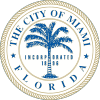Overtown (Miami)
Overtown is located just northwest of downtown Miami. Overtown is bounded by NW 5th Street to the South, NW 20th Street to the North, the FEC Corridor and NW 1st Avenue to the East, and NW 7th Avenue to the West. It is adjacent to the neighborhoods of Allapattah, Spring Garden, Wynwood, Park West and is directly north of Downtown. The neighborhood is bisected east-west by Interstate 95 (I-95) and north-south by Interstate 395. At its peak, Overtown was home to more than 40,000 residents. It currently has a population of approximately 8,000, of which more than 90% are African American.
Longtime residents of the neighborhood are affectionately known to each other as "Towners" and they represent themselves and the neighborhood by the popular phrase, "Towners For Life!"
History
Overtown is one of the oldest neighborhoods in Miami. In 1896 the City of Miami was incorporated when Henry Flagler, was building the railroad, needed a place for workers to live. Because at this time Jim Crow laws prevented Blacks from living within any area they desired, the land west of the railroad tracks was designated as “Colored Town.” This was the beginning of a unique Black community that is now known as OVERTOWN. Even under segregation, Colored Town grew into a vibrant community. Schools, businesses and churches flourished. In 1904 the City of Miami directory listed numerous businesses that included hotels, grocery and furniture stores, markets barbershops, theaters, and nightclubs. Manufacturing was limited to the production of “soda water” at the Cola Nip Bottling company, owned and operated by two black men, Osbourne Jenkins and William Sampson.

Tourists of all races, and locals alike enjoyed the vibrant life of the area. Overtown was a place known for its nightly entertainment, exotic restaurants and active churches. Celebrities such as Count Basie, Ella Fitzgerald, Cab Calloway, Josephine Baker, Billy Holiday, Nat King Cole, Aretha Franklin and many other artists performed year round at the Sir John Hotel, Mary Elizabeth Hotel, the Lyric Theater and other Overtown establishments. In addition, many prominent Blacks such as W. E. B. Du Bois, Zora Neale Hurston, Joe Louis and Jackie Robinson stayed in Overtown when vacationing in Miami.
Over the years Overtown lost its magic. Many of its core residents moved out of the area as Jim Crow laws were overturned and Blacks had more choices in where they could live. In the 1960s, two interstates were constructed through the heart of the neighborhood, displacing many residents. In the 1970s, urban renewal programs called for the demolition of housing in Overtown, displacing even more residents. In the 1980s, civil disturbances rocked the neighborhood and many buildings were destroyed, abandoned or fell into disrepair. It became and still is one of the poorest neighborhoods in South Florida, but since 2000 the Overtown Renaissance, a movement to restore the neighborhood, has begun. Over the next five years, middle-class housing will continue to be built in the area, as the downtown Miami area enfringes on Overtown.
Landmarks
Overtown is home to several historic churches and landmarks including Greater Bethel AME, Mt. Zion, St. John Baptist and St. Agnes church. Some of the neighborhood historic landmarks are the Dorsey House (reconstructed home of the first black millionaire in Miami D.A.Dorsey), Old Black Police Precinct (home of the only black courthouse and police station in Miami) and L.E. Thomas Building (home of the first black magistrate in Miami).
The Lyric Theater
Overtown is home to the legendary Lyric Theater. Opened in 1913, the Lyric Theater quickly became a major entertainment center for blacks in Miami. The 400-seat theater was built, owned and operated by Geder Walker, a black man from Georgia. In 1915 the Miami Metropolic newspaper described the Lyric Theater as, "possibly the most beautiful and costly playhouse owned by Colored people in all the Southland." The Lyric Theater served as a symbol of black economic influence, as well as a social gathering place-free of discrimination- and a source of pride and culture within Overtown. The theater anchored the district know as "Little Broadway," an area alive with hotels, restaurants and nightclubs frequented by the black and white tourists and residents. Clyde Killens, a local resident and entertainment promoter, was primarily responsible for bringing black entertainers -- who could perform in the clubs on Miami Beach but not stay in the hotels -- to Overtown, the Lyric Theater and "Little Broadway." Little Broadway's roster of stars was spectacular and featured performers including Count Basie, Sam Cooke, Aretha Franklin, the Ink Spots, B.B. King, Patti LaBelle, Ella Fitzgerald, Redd Foxx and Mary Wells. When Overtown began to deteriorate in the 1960's the Lyric Theater closed and would remain shuttered for four decades.
The Future
Development pressure is increasing on Overtown, with promises of new housing and retail projects that will bring middle-class residents to downtown's historically black neighborhood. But even as developers maneuver to remake the area, Overtown remains the city of Miami's poorest neighborhood.
Education
Miami-Dade County Public Schools serves Overtown.
- Booker T. Washington serves Overtown.
- Fredrick Douglass serves Overtown.
Phillis Wheatley Elementary School serves Overtown.


